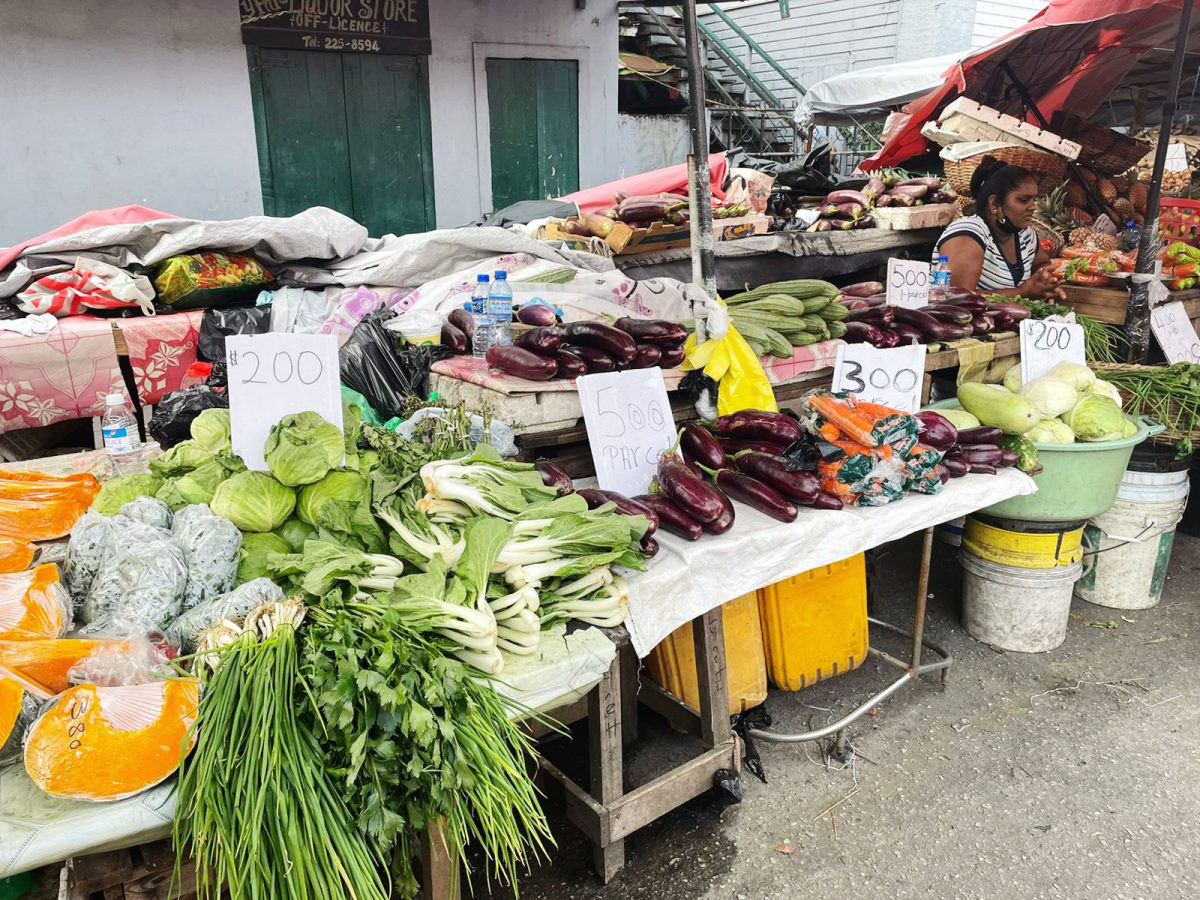A sampling of urban working class Guyanese, predominantly women with school-age children did not find them as upbeat as President Irfaan Ali might have hoped they may be about what he had to say recently about the “deliberate initiatives and policies” that his administration has undertaken “over the last four years to address the rise of global food prices and cushion the cost of living for Guyanese.”
After the President had been quoted in an official release published on Saturday August 3 as saying that his government had “implemented deliberate initiatives and policies over the last four years to address the rise of global food prices and cushion the cost of living for Guyanese,” respondents to whom the Stabroek Business spoke to during visits to two urban municipal markets expressed the view that current food prices, particularly the prices of fruits and vegetables cultivated in Guyana, continue to be beyond the reach of large numbers of urban Guyanese for whom – according to one respondent – shopping in urban municipal markets has become a permanent bargain-hunting exercise on account of what our fourteen respondents told us were the exorbitant prices of meats, fruit and vegetables.
In response to a question posed by the Stabroek Business, most of our respondents pointed to the dichotomy between the country’s ‘boast’ about being the food basket of the Caribbean, on the one hand, and the prevailing high prices of fruit and vegetables, on the other.
One farmer who ‘doubles up’ as a fruit and vegetable vendor pointed to the incessant complaints about the high prices of vegetables and fruit in the country’s municipal markets. One respondent told the Stabroek Business that the prices for some fruit vegetables had ‘reduced’ her to “spending time and energy shopping around” and that she believed a point had been reached where low-income consumers in Guyana can “reasonably” compare their circumstances with consumers elsewhere in the region whose food security profiles are considerably lower than our own. Here it is a question where most of our respondents feel making comparisons between Guyana, long regarded as the food basket of the Caribbean, and the less food-secure countries of the region for whom high prices for vegetables and meats, particularly mean that in poor families these items have no regular place on the dinner table.
While the President’s recent broadcast about what a state release said were “the government’s deliberate measures to keep food prices down” compared favourably with “the rise in global food prices and the costs of transportation, goods and services resulted from the Russian-Ukraine war, and the global pandemic, among other disruptions,” here in Guyana, the highly touted food basket of the region afflicted by none of the constraints that impact other regions of the world, the clamor over food prices, not least in the agri-foods sector remains unabated. Bourda, La Penitence, Stabroek and Mon Repos, the markets visited by the Stabroek Business over the past week, found shoppers all ‘singing the same tune’ about exorbitant food prices that continue to push way ahead of consumer earnings.
Whereas the report on what President Ali had to say about global food security sought to make comparisons with “the European Union,” where, “food price inflation increased from the last quarter of 2021 to reach 3.5 per cent in January and 7.5 per cent in May 2022 and in Latin America and the Caribbean where food price inflation surged steadily from January 2022 to 81.6 per cent by September 2023,” it made no mention of the fact that the disparity between earnings, on the one hand and cost of living, on the other, meant that there are numerous instances in which prices for locally produced foods remain way ahead of consumer earnings.
When the Stabroek Business put to shoppers the point reportedly made by President Ali about “the way we have been able to manage to cushion these costs” respondents in the aforementioned markets pointed to the prevailing prices for meat and vegetables, particularly, against the backdrop of affordability, some pointing out that the reality was that among working class Guyanese, wages and salaries are simply not keeping pace with continually rising food prices.
Several respondents told the Stabroek Business that vegetable and fruit vendors in the country’s coastal municipal markets were enjoying a proverbial ‘field day,’ effecting upward adjustments in prices – in some instances on almost a daily basis –leaving consumers at their wit’s end insofar as budgeting is concerned. While the report on the President’s pronouncements asserted that the government had implemented “a slew of measures to further reduce food inflation such as the removal of value added tax (VAT) on fertilizers, agrochemicals, pesticides and several inputs in the poultry industry, at an annual estimated cost of $262 million,” the handful of respondents to questions raised on this issue asserted that there was no evidence of linkages between those considerations and the unrelenting price hikes that obtain in municipal markets across the country.
One University of Guyana student shopping at La Penitence Market last week told the Stabroek Business that President Ali’s comment Guyana’s “food inflation rates” compared to “all the other regions” asserted that the ‘bottom line’ about ‘food security’ is “food affordability… If the cost of food exceeds what you earn then we’re in trouble, it doesn’t matter who says what,’ she told the Stabroek Business. High food prices and ceaseless complaints about food affordability has become close to the top of the range of concerns ‘doing the rounds’ at various public debating fora. Whereas in previous years ‘night-time shopping’ outside municipal markets provided some level of assurance of benefitting from end-of-day (reduced) fruit and vegetable prices, particularly, vendors these days, keen to maximize their earnings, extend their working hours aggressively ‘holding out’ for prices set at the start of the trading day.






